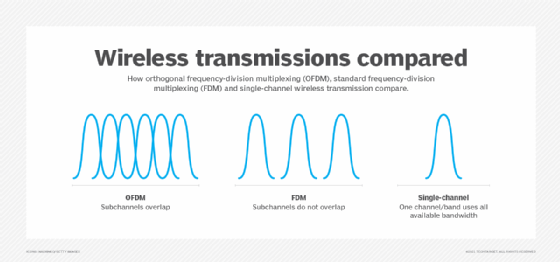orthogonal frequency-division multiplexing (OFDM)
What is orthogonal frequency-division multiplexing (OFDM)?
Orthogonal frequency-division multiplexing is a method of data transmission where a single information stream is split among several closely spaced narrowband subchannel frequencies instead of a single Wideband channel frequency. It is mostly used in wireless data transmission but may be employed in wired and fiber optic communication as well.
In a traditional single-channel modulation scheme, each data bit is sent serially or sequentially one after another. In OFDM, several bits can be sent in parallel, or at the same time, in separate substream channels. This enables each substream's data rate to be lower than would be required by a single stream of similar bandwidth. This makes the system less susceptible to interference and enables more efficient data bandwidth.

How orthogonal frequency-division multiplexing works
In the traditional stream, each bit might be represented by a 1 nanosecond segment of the signal, with 0.25 ns spacing between bits, for example. Using OFDM to split the signal across four component streams lets each bit be represented by 4 ns of the signal with 1 ns spacing between. The overall data rate is the same, 4 bits every 5 ns, but the signal integrity is higher.
As an illustration, imagine you were sending a letter to your grandmother. You could write your letter on a single piece of paper and mail it to her in an envelope. This would be like using a single frequency (one piece of paper) to send your entire message. But, because your grandmother can't see well, you instead write the same message in larger letters (a slower data rate) on several pieces of paper (representing data streams on different channels) but put them all in the same envelope (using same overall frequency spectrum).
OFDM builds on simpler frequency-division multiplexing (FDM). In FDM, the total data stream is divided into several subchannels, but the frequencies of the subchannels are spaced farther apart so they do not overlap or interfere. With OFDM, the subchannel frequencies are close together and overlapping but are still orthogonal, or separate, in that they are carefully chosen and modulated so that the interference between the subchannels is canceled out.
Extending orthogonal frequency-division multiplexing
OFDM has been further extended into what's called orthogonal frequency-division multiple access (OFDMA). OFDMA enables devices sharing the same overall channel to have the component subchannels dedicated to specific devices.
To extend the above illustration, OFDMA would be like including a single-page letter to your grandfather in the same envelope as the letter to your grandmother. Since all devices on the same channel share the same collision domain, this reduces the need for the devices to wait or take turns to receive data. This will specifically help in situations where a device needs a low, but consistent, stream of data or in situations where many devices are connected to a single base station. This is a key feature in Wi-Fi 6, 4G and 5G new radio (5G NR) cellular data to support high data rates and many devices, especially for internet of things (IoT) devices.
Implementing orthogonal frequency-division multiplexing
There are several ways to implement an OFDM system with differing characteristics, guard intervals and modulation schemes. Coded orthogonal frequency-division multiplexing (COFDM) includes coded forward error correction and is the most common implementation -- so much so that the terms COFDM and OFDM are used interchangeably in most applications.
Some less common standards include fast low-latency access with seamless handoff OFDM (Flash-OFDM), vector OFDM (VOFDM), scalable OFDMA (SOFDMA), wavelet OFDM (W-OFDM), cyclic prefix OFDM (CP-OFDM), windowed OFDM, filtered OFDM, universal filtered OFDM, unique word OFDM and pulse shaped OFDM.
OFDM advantages and disadvantages
Orthogonal frequency-division multiplexing has many advantages over a single-channel data transmission approach. Primarily, OFDM is more resilient to electromagnetic interference, and it enables more efficient use of total available bandwidth because the subchannels are closely spaced. It is also more resistant to interference because several channels are available.
Advanced error correction can be used to spread out the overall data and compensate for small errors. So, narrowband interference on a single subchannel will not affect the other channels, enabling the overall system to still operate. Frequency-selective interference fading due to multipath echo effects can also be corrected. The lower data rate on the individual subchannels enables guard intervals to be used between symbols, which eliminates intersymbol interference and helps with multipath errors.
There are two primary disadvantages with OFDM compared to single-channel systems. OFDM systems must have closely tuned transmitters and receivers. This requires the timing on signal modulators and demodulators be closely matched and produced to tight tolerances. It also makes the system more sensitive to Doppler shift and, therefore, less effective for high-speed moving vehicles.
OFDM also has several advantages compared to standard frequency-division multiplexing. The radio frequency receiver is simpler in OFDM because the entire signal can be received in a single frequency selective filter and separated in software using a fast Fourier transform, while an FDM system requires a separate RF bandpass filter for each channel. It also has better overall bandwidth efficiency. There are some disadvantages in that the higher overall peak-to-average power (PAPR) ratio requires less efficient linear transmission circuitry.
OFDM applications
Orthogonal frequency-division multiplexing is used in many technologies, including the following:
- Digital radio, Digital Radio Mondiale, and digital audio broadcasting and satellite radio.
- Digital television standards, Digital Video Broadcasting-Terrestrial/Handheld (DVB-T/H), DVB-Cable 2 (DVB-C2). OFDM is not used in the current U.S. digital television Advanced Television Systems Committee standard, but it is used in the future 4K/8K-capable ATSC 3.0 standard.
- Wired data transmission, Asymmetric Digital Subscriber Line (ADSL), Institute of Electrical and Electronics Engineers (IEEE) 1901 powerline networking, cable internet providers. Fiber optic transmission may use either OFDM signals or several distinct frequencies as FDM.
- Wireless LAN (WLAN) data transmission. All Wi-Fi systems use OFDM, including IEEE 802.11a/b/g/n/ac/ax. The addition of OFDMA to the Wi-Fi 6/802.11ax standard enables more devices to use the same base station simultaneously. OFDM is also used in metropolitan area network (MAN) IEEE 802.16 Worldwide Interoperability for Microwave Access (WiMAX>) installations.
- Cellular data. Long-Term Evolution (LTE) and 4G cellphone networks use OFDM. It is also an integral part of 5G NR cellular deployments.
- Other proprietary systems.






